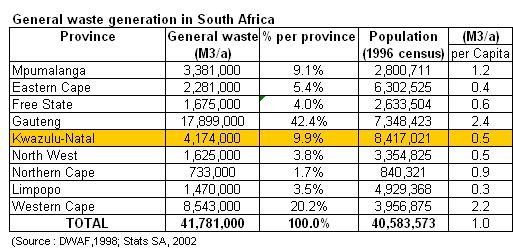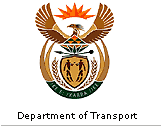 |
Waste DisposalAccording to the report of the Department of Water Affairs
and Forestry, over 42 million cubic metres of general
waste is generated every year across the country, with the
largest proportion coming from Gauteng (42%) (DWAF1997).
KZN is the third largest generator of waste
among the provinces with 9.9% of the national total.
In addition, more than 5 million cubic metres of hazardous
waste are produced every year, mostly in Mpumalanga and
KwaZulu-Natal (due to the concentration of mining
activities and fertiliser production in these provinces).
The average amount of waste generated per person per day
in South Africa is 0.7 kg. The figure for KwaZulu-Natal
is 0.5 kg, which is much lower than the average produced
in developed countries (7.3 kg in the UK and 0.87 kg in
Singapore), but higher than the average in some poorer
countries such as 0.3 kg in Nepal (DWAF 1997).
Total general waste from households, commerce,
institutions, and the manufacturing industry was
approximately 13.5-15.0 million tons per year in
1998, which must have increased to more than 20 million
tons over the last 14 years due to rising population and
economic growth.
In addition, a further 22 million tons per year of
industrial wastes are generated, handled, and disposed of
in-house (on-site). Nationwide, about 8.8 million tons
of domestic waste required collection and disposal in the
financial year 2004/2005. During the six years from 2004
to 2010, domestic waste is predicted to rise by 1.1
million tons to some 10 million tons or more.

|
Solid Waste Collection and DisposalIn KZN the normal method of disposal of solid waste is by
burying them in sanitary landfills, often called dumps,
which are tracts of land used to dispose of waste
materials. It is believed that the escape of harmful gases
from landfills into the atmosphere contributes to the
pollution of the environment, and to global warming.
Local authorities are mandated to collect, handle and
dispose of domestic waste from all households, and to
ensure an equitable service to their communities. General
landfill sites accept domestic, commercial and
industrial non-hazardous, building and garden
waste. These sites are more often owned and operated by
the local authority. Because many of these landfills do
not have records of incoming waste, due to the lack of
funds and capacity, up-to-date information is not readily
available. eThekwini (Durban)The eThekwini municipality has access to three landfill
sites.
1. La Mercy, located at 35 km north of Durban.
2. Bisasar Road some 7 km from the Durban CBD (Central
Business District).
3. Mariannhill located 20 km to the west of the CBD.
The Mariannhill landfill, which has a 4,4 million cubic
metre capacity, has been in operation since 1997 and
receives about 850 tons of solid waste a day. The lifespan
of this landfill site is estimated to be until 2024. The
landfill also has a full treatment plant for leachate (the
liquid that oozes from waste when mixed with water or
other liquids). There is also a pilot recycling facility
on site that recycles various materials. uMhlatuze (Empangeni – Richards Bay)With regard to the Empangeni-Richards Bay area,
there
are landfill sites close to Empangeni Rail. This site
(located on State Land), licensed by the Department of
Water Affairs, is currently reaching maximum capacity. The
Richards Bay landfill site is situated close to Alton near
the old sewage works, and is exceeding capacity. The solid
waste disposal sites in Empangeni and Richards Bay are,
however, reaching capacity, and a regional landfill site
near Empangeni is being investigated.
A regional site for the City of uMhlathuze was identified
adjacent to the Empangeni landfill site. The site will be
operated as a public/private partnership with the District
Municipality. The existing waste disposal facilities in
uMhlathuze Municipal area do not meet the industrial waste
disposal needs of these areas. Such a site should have the
capacity to accommodate a total waste stream of 583 530
tons by the year 2018. The arrangements recorded for the above cities are also
typical of the many municipalities around the province
which have established landfills for disposal of solid and
liquid wastes. Most of the cities and towns such as
Pietermaritzburg, Newcastle, Ladysmith, Stanger, Port
Shepstone and Howick have designated landfills, and control
the collection and disposal of wastes to the best of the
council’s abilities and resource allocations.
Smaller
towns have very often to employ contractors to transport
wastes to regional sites managed by larger cities. According to the baseline studies published in 1998,
however, there could be up to 15 000 unrecorded communal
sites in the rural areas. Many illegal waste disposal
sites have developed over the years due to a number of
reasons such as the lack of collection services, long
transport distances to formal disposal sites, the refusal
by the public or industry to pay landfill fees,
excessive bureaucracy and costs in waste disposal
services, indifference or disbelief in the published
environmental consequences of poor waste handling and
disposal, and the lack of waste education and awareness.
Information on the volumes of waste re-used, reduced and
recycled is not readily available in South Africa due to
current lack of provincial and national waste information
systems.
The transport of solid waste is a significant road
transport undertaking within the province with more than 4
million cubic metres (about 1.5 million tons) being
transported per year and increasing steadily with
urbanisation, increased regulation and increasing
dependence on the urban and local authorities to dispose
of waste in the prescribed manner.
|
 |



